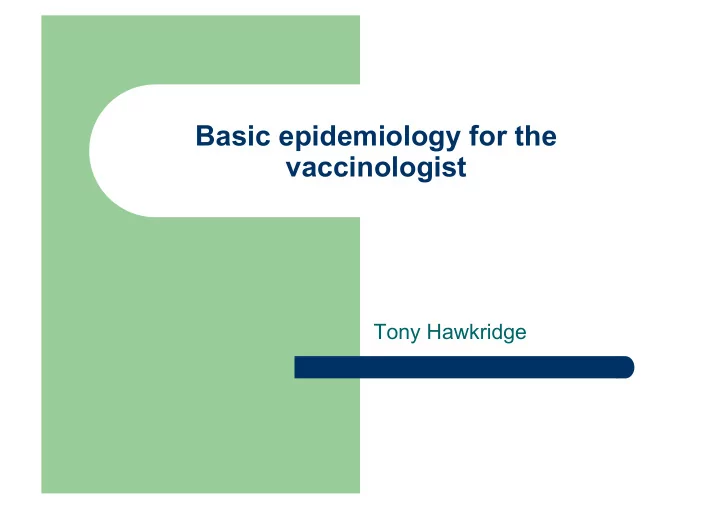

Basic epidemiology for the vaccinologist Tony Hawkridge
What is epidemiology? The study of the frequency, causes and distribution of disease and the control thereof. “Epidemiology is a slippery concept!” (Prof Jonny Myers; Dept Public Health, UCT; ca 1999)
Question Why should vaccinologists or budding vaccinologists pay any attention at all to epidemiology?
What I think… Can’t measure it = can’t manage it – Measurement sciences – epidemiology, statistics, information management, etc Can’t measure it = can’t prioritise and plan properly Can’t measure it = can’t impute causality, design interventions, understand mechanisms properly – ideas / hypothesis generation Good epidemiology underlies much research – both basic science and clinical.
Learning Objectives At the end of this session, you should know: The definition of epidemiology The difference between incidence and prevalence. The different kinds of study design and what study design is used in clinical trials. How vaccine efficacy is calculated and interpreted. The difference between vaccine efficacy and vaccine effectiveness.
Incidence and prevalence Prevalence The proportion of disease occurring at a point in time e.g. 100 out of a 1000 people are HIV positive in a survey done in October 2007 = 100/1000 *100 = 10% prevalence. Incidence The number of NEW cases of disease in a population over a specified time period e.g. 1000 new TB cases in 2007 in a population of 100 000. = 1000/100 000 *100 = 1% incidence in 2007.
Question Which is more important in vaccinology, incidence or prevalence and why?
Study designs Observational Case series – A simple description of a series of cases of diease. Cross-sectional study – a description of a defined group at a point in time – prevalence. Case Control study – a group of cases is compared to a selected group of controls to determine causes. Cohort study – defined group is followed up over time to determine incidence of disease (with the initial group possibly being classified by exposures)
I Intervention studies - Clinical trials Studies where researchers administer an intervention e.g. drug, vaccine or educational intervention. Controlled Randomised Blinded – single, double, triple
Advantages and disadvantages of different study designs Cost Ability to study rare diseases/ outcomes. Time needed to do the study. Descriptive or analytic output needed. Prone to bias or not.
How is a vaccine efficacy study done? Phase III trial. Usually double blind, randomised and controlled. i.e. conditions are idealised. Strict inclusion and exclusion criteria Sample size determined based on expected incidence of disease in unvaccinated and estimated incidence in vaccinated. Usually for a limited period.
Vaccine effectiveness Evaluation of a vaccine under field conditions to determine operational feasibility. Other kinds of study designs used: before/ after, case control, long term cohort follow up, outbreak investigation. Be wary of biases and confounding. Usually not blinded nor randomised. May include whole populations. Long term follow up possible. Under field conditions so less controlled and less standardised.
Phase IV evaluation Post licensure. Efficacy in special risk groups. Surveillance for rare safety events.
Bias and confounding Bias is a factor which distorts the validity of an outcome measure of a study e.g. recall, selection, misclassification. Confounding is a special bias where a factor is associated with both the exposure and the disease outcome e.g. coffee may come up as a risk factor for lung cancer but this may be due to smoking being associated with coffee drinking and lung cancer.
Definition of vaccine efficacy/ effectiveness The degree to which a vaccine reduces the number of cases due to a disease. Traditionally VE = Percentage (%) reduction in disease incidence attributable to vaccination (H Hohynek)
Measurement of vaccine efficacy RR = AR V / AR U VE = 1 - RR AR V = attack rate in vaccinated VE (%) = AR U = attack rate in (ARU - ARV) unvaccinated x 100 ARU [= (1 – ARV) x 100] ARU
Calculating Vaccine efficacy - example Rate of disease in those who got placebo – 100 out of 1000. Rate of disease in those who got vaccine – 10 out of 1000. What is the vaccine efficacy?
Calculation in our example (ARU - ARV) x 100 ARU 100/1000 – 10/1000 X 100 = 100/1000 0.1 – 0.01 X 100 = 0.09 X 100 0.1 0.1 = 0.9 X 100 = 90%
Basic statistical measures Average measures: mean, median and mode Proportions (often expressed as percentages). Data classification process – categorical/ numerical (discrete or continuous). Statistical tests depend on type of data. Multivariate analyses
Immunisation coverage
Concluding summary Basic epidemiological measures are crucial to vaccinology. Vaccine efficacy is measured through randomised, controlled, blinded clinical trials. There are different study designs that can be used to determine vaccine effectiveness.
Recommend
More recommend